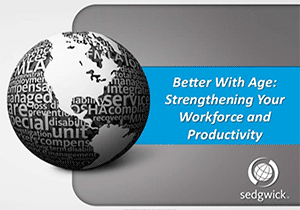In my last blog, I discussed the value of a mature workforce. Are you interested in developing a plan to keep your aging workforce engaged, productive and injury-free? As you begin working on a plan, some key facts about how age should be considered:
- Strength: Decreases by 25-30% at age 65
- Flexibility: Decreases by 18-20% at age 65
- Balance: One third of individuals 65 or older fall each year
- Sight: All aspects deteriorate
- Reaction: Time and speed decreases
- Hearing: One third of 65-year-olds have problems
- Manual dexterity: Decreases
- Body fat: Increases
Most aging employees do not want to admit they are changing and do not want to ask for help in adapting or improving their workspace. They may find they are fatigued more easily or have issues with tripping more frequently. They may also experience a loss of patience and be more irritable. Their supervisors may start providing feedback that their work performance is declining. Frequently, their number and pattern of sick days changes and they may start to have a history of near misses or minor injuries at work. Staying engaged in the workforce, however, is positive for both the employer and the aging worker.

Work is beneficial as we age for a number of reasons. It provides access to better and more affordable healthcare, it helps to maintain a better cognitive function, and also a longer life span. Retention of the older worker also allows companies to retain knowledge and better organizational health.
When implementing a new workplace design for your mature workforce, I would recommend dividing your strategies into two categories: above the shoulders and below the shoulders.
Above the shoulders:
- Vision
- Hearing
- Cognitive ability
Key strategies for above the shoulders:
- Increase lighting by 20-30%
- Provide visual and audio information to machine operators
- Use LED lighting to make defects more visible
- Avoid use of small print on instructions and equipment
- Use LCD displays for reduced glare
- Slow the rate of information presented
Below the shoulders:
- Strength
- Heat stress
- Shift work
- Connective tissue
- Musculoskeletal disorders
- Slower reaction times
- Loss of balance
Key strategies for below the shoulders:
- Improve illumination for walking surfaces and stairs
- Clear markings should be on the first and last two steps
- Avoid swing shift scheduling
- When precision tools are needed, provide a higher coefficient of friction between the operator’s fingers and the tool surface
- Avoid working at heights
- Address uneven walking surfaces and keep surfaces clear of clutter and debris
- Team older workers with younger workers when lifting is involved
- Avoid very hot and very cold work environments
A well-designed workplace benefits everyone. When workplace flexibility is an option and the workplace is structured to take into account the health and wellness of all employees, a company is able to have a very capable and experienced workforce in place. It is a win for everyone involved.
Have you put any strategies into place at your workplace? What have you experienced? Have you met any challenges? What solutions have worked best?
Susan Shemanski, VP, Client Services